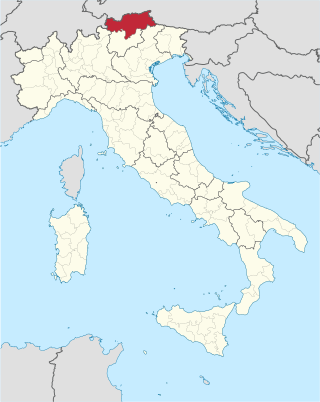
South Tyrol is an autonomous province in northern Italy. An English translation of the official German and Italian names could be the Autonomous Province of Bolzano – South Tyrol, reflecting the multilingualism and different naming conventions in the area. Together with the autonomous province of Trento, South Tyrol forms the autonomous region of Trentino-Alto Adige/Südtirol. The province is the northernmost of Italy, the second largest with an area of 7,400 square kilometres (2,857 sq mi), and has a total population of about 534,000 inhabitants as of 2021. Its capital and largest city is Bolzano.

Bolzano is the capital city of the province of South Tyrol, in Northern Italy. With a population of 108,245, Bolzano is also by far the largest city in South Tyrol and the third largest in historical Tyrol. The greater metro area has about 250,000 inhabitants and is one of the urban centers within the Alps.

Trentino-Alto Adige/Südtirol is an autonomous region of Italy, located in the northern part of the country. The region has a population of 1.1 million, of whom 62% speak Italian as their mother tongue, 30% speak South Tyrolean German and several foreign languages are spoken by immigrant communities. Since the 1970s, most legislative and administrative powers have been transferred to the two self-governing provinces that make up the region: the province of Trento, commonly known as Trentino, and the province of Bolzano, commonly known as South Tyrol. In South Tyrol, German remains the sizeable majority language.

Neumarkt is a comune (municipality) and a village in South Tyrol in northern Italy, located about 25 kilometres (16 mi) south of the city of Bolzano. It is one of I Borghi più belli d'Italia.

The South Tyrol Option Agreement was an agreement in effect between 1939 and 1943, when the native German and Ladin-speaking people in South Tyrol and several other municipalities of northern Italy, which had belonged to Austria before WWI, were given the option of either emigrating to neighboring Nazi Germany or remaining in Fascist Italy, where the German minority was subjected to repressive Italianization efforts.
The Prontuario dei nomi locali dell'Alto Adige is a list of Italianized toponyms aimed at replacing the place names used by the German language community in South Tyrol which was published in 1916 by the Royal Italian Geographic Society. The list was called the Prontuario in short and later formed an important part of the Italianization campaign initiated by the fascist regime, as it became the basis for the official place names in the predominantly German-speaking Italian-annexed southern part of the County of Tyrol.

Salorno sulla Strada del Vino is the southernmost comune (municipality) and a village in South Tyrol in northern Italy, located about 30 kilometres (19 mi) southwest of the city of Bolzano. It is one of only five mainly Italian-speaking municipalities in South Tyrol.
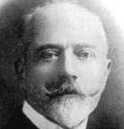
Ettore Tolomei was an Italian nationalist and fascist. He was designated a Member of the Italian Senate in 1923, and ennobled as Conte della Vetta in 1937.
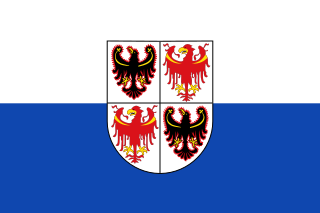
The Politics of Trentino-Alto Adige/Südtirol takes place in a framework of a parliamentary representative democracy, whereby the President of Regional Government is the head of government, and of a pluriform multi-party system. Executive power is exercised by the Regional Government and Legislative power is vested in both the government and the Regional Council. However, since a constitutional reform in 1972, almost all the executive and legislative powers are devolved to the two provinces of which the region is composed: Trentino and the South Tyrol.

In 1919, at the time of its annexation, the middle part of the County of Tyrol which is today called South Tyrol was inhabited by almost 90% German speakers. Under the 1939 South Tyrol Option Agreement, Adolf Hitler and Benito Mussolini determined the status of the German and Ladin (Rhaeto-Romanic) ethnic groups living in the region. They could emigrate to Germany, or stay in Italy and accept their complete Italianization. As a consequence of this, the society of South Tyrol was deeply riven. Those who wanted to stay, the so-called Dableiber, were condemned as traitors while those who left (Optanten) were defamed as Nazis. Because of the outbreak of World War II, this agreement was never fully implemented. Illegal Katakombenschulen were set up to teach children the German language.

Oskar Peterlini is an Italian political writer and Lecturer at the Free University of Bozen Bolzano.
The South Tyrolean Unterland or Bozen Unterland is a section of the Etschtal valley stretching from the regional capital Bolzano (Bozen) down the Adige (Etsch) river to Tramin and Salorno (Salurn). The area is known for its history, particularly regarding Rhaetic, Roman, and Germanic archaeological sites; its bilingualism, and its viticulture; the Gewürztraminer grape originated here.
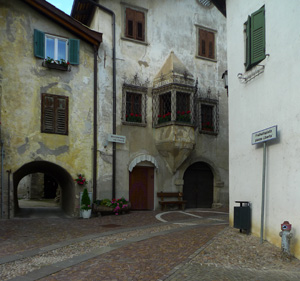
Laag is a frazione of the comune of Neumarkt in South Tyrol in the Italian region of Trentino-Alto Adige/Südtirol, located about 30 km northeast of the city of Trento and about 25 km south of the city of Bolzano. Laag is situated on the plain on the left side of the Adige river.
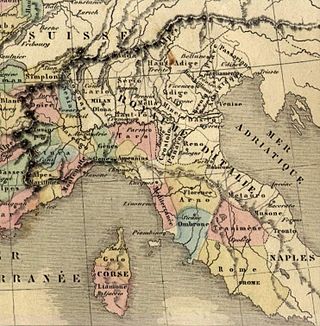
The Department of Alto Adige was a northern department of the Napoleonic Kingdom of Italy. The name had been used for a district of the Cisalpine Republic. Its name, in typical Napoleonic fashion of naming departments after geographic features, derived from the river Adige which flowed through it.
Franz Thaler was an author from South Tyrol, a peacock quill embroiderer and a survivor of the concentration camp in Dachau and satellite camp in Hersbruck.
Armando Ronca was an Italian architect who has executed numerous buildings and interior designs, mainly in South Tyrol, Trentino and Milan.
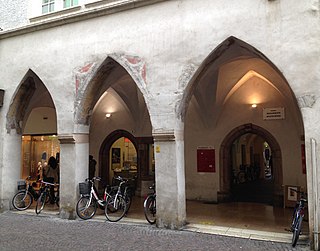
The Civic Archives in Bozen-Bolzano are the municipal archive of the city of Bolzano in South Tyrol, Italy. They are located in the old town hall and store documents from over 700 years of civic and regional history.

The cathedral Maria Himmelfahrt is the parish church of the South Tyrolean capital Bolzano and cathedral of the Diocese of Bozen-Brixen. While the Bishop has resided in Bozen since 1964, the cathedra and the cathedral chapter remain in Brixen. Maria Himmelfahrt is therefore with Brixen Cathedral co-cathedral of the diocese.
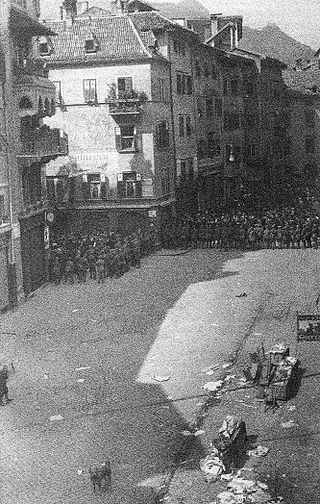
Bozner Blutsonntag refers to the events of 24 April 1921 in Bozen. It was the first climax of fascist violence in South Tyrol, a German-speaking province that was annexed by Italy after World War I.















